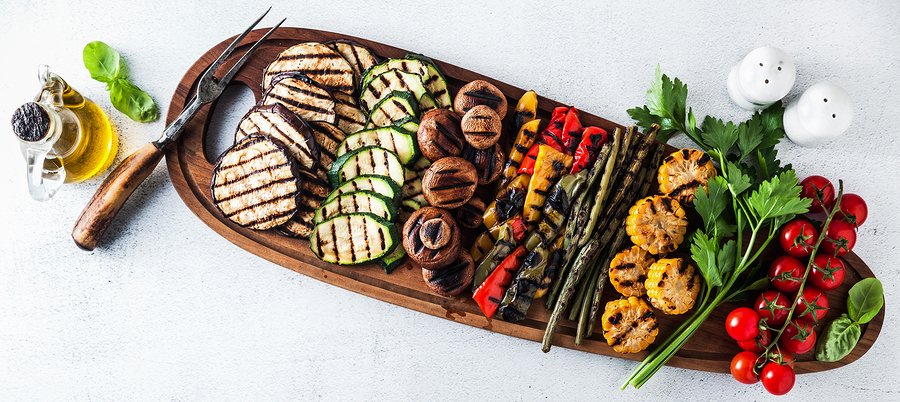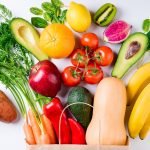June 21st may be the official start of summer, but May is generally considered its unofficial start. Temperatures are on the rise, flowers are in bloom, and shorts and sandals are pulled out from the back of the closet. What’s more, the weather is often perfect for barbecuing, giving you the opportunity to spend a little extra time outdoors instead of stuck in the kitchen.
That’s why we are thrilled to join in the celebration of May as National BBQ Month. But instead of glorifying the kinds of barbecue fare you may have grown up eating—featuring hot dogs, cheeseburgers, and potato salad—we want to offer a few ideas for healthier barbecuing.
With a little preparation, you will soon be ready to enjoy evenings of backyard cooking that will culminate with dining on nutritious meals. Read on for five of our favorite tricks.
1. Center the Menu Around Vegetables
Okay, so traditionally barbecues are all about the meat, but they really don’t need to be. We’re not saying you shouldn’t serve any animal protein, but if you want to keep the meals healthier, you are better off with grilled vegetables as the centerpiece. Choose hearty vegetables such as Portobello mushrooms, zucchini, eggplant, peppers, and onions lightly dressed in balsamic vinegar and fresh herbs such as oregano, rosemary, and thyme for delicious, light summery fare. Add a three-ounce portion of salmon or organic free-range chicken breast when you want to include some protein. And, of course, there are always veggie burgers and, if you know how to do it, thick tofu steaks.1 http://www.seriouseats.com/2015/02/the-food-lab-how-to-grill-tofu-vegan-experience.html
2. Cut Out Excess Calories
Skip all the side dishes that are drowning in mayo, such as coleslaw and macaroni salad. Instead, consider serving kale salad, grilled sweet potatoes, and bean salad. If you’d like to offer condiments to accent the flavors to each diner’s preference, forgo the refined salt in favor of cilantro and unrefined sea salt, and definitely pass on bottled barbecue sauce, which is typically laden with sugar and preservatives.
3. Practice Food Safety
Food subjected to high heat can produce some dangerous by-products. Some of the most notable include:
- Heterocyclic amines and polycyclic aromatic hydrocarbons
- Advanced glycation end products AGEs
- Acrylamide
Barbecuing meat can cause the formation of carcinogens that are associated with cancer. This is not only a problem with red meat, but can occur in cooking chicken and fish as well. The very high temperatures can result in the breakdown of creatinine, an amino acid in the meat, forming dangerous heterocyclic amines (HCAs). To avoid this, start by marinating any meat you’re cooking. A 2008 study at Kansas State University in Manhattan found that using herbal marinades on meat sharply reduces the level of HCAs.2 Smith, J.S.; et al. “Effect of Marinades on the Formation of Heterocyclic Amines in Grilled Beef Steaks.” Journal of Food Science. August 2008. Accessed 18 April 2018. http://onlinelibrary.wiley.com/doi/10.1111/j.1750-3841.2008.00856.x. But unfortunately, barbecuing may also contribute to the formation of polycyclic aromatic hydrocarbons (PAHs), which are produced when animal fat drips onto the heating elements. They then rise in the smoke and settle on the food being cooked, or form directly when the meat is charred. To combat this hazard, cook the meat at lower temperatures and use a drip pan to keep any fat from hitting the heat source. And if anything does become burned—even the vegetables—cut those sections off and discard them. (Note: although plant sources of protein do contain creatinine, they contain less than non-vegetarian sources.)
Heating sugars and proteins can create AGEs. Jon has talked extensively about how AGEs degrade proteins, and all the organs made from them, and accelerate aging in your body. And as with HCAs, plant foods tend to produce less of them when heated VS meat—although in this case, it’s only slightly less.
Acrylamide in food forms from sugars and an amino acid that are naturally present in food. Specifically, when it comes to amino acids, acrylamide can be generated from asparagine or from amino acids that can produce acrylic acid either directly such as beta-alanine, aspartic acid, and carnosine or indirectly such as cysteine and serine. Food sources that have been in the news recently include barbecued meat, French fries, and coffee.
Bottom line: when you grill, lightly grill; don’t char. Most of the damage is found in the char.
4. Be a Good Guest
When you are invited to someone else’s home for a barbecue, you don’t have much control over what is served. Chances are good that there will be a lot of unhealthy foods on the table. To make sure you don’t end up with a heaping plate of hot dogs and macaroni salad, eat something at home shortly before you leave. Even a little healthy snack of hummus with whole grain crackers or apple slices should fill you up enough that you won’t go too crazy indulging in the food at the barbecue. And don’t forget to bring a nutritious dish with you as your contribution to the meal. At least, that way, you’ll know you will have one option that’s definitely healthy.
5. Take Advantage of Being Outside
More than just enjoying the fresh air while you grill, you can put barbecue time to good use by getting active. While waiting for some of your food to cook over low heat (see tip #3), organize a friendly game of tag, whiffle ball, or Frisbee. And when the meal is over, stay outside a while and go for an evening walk or bike ride.
References
| ↑1 | http://www.seriouseats.com/2015/02/the-food-lab-how-to-grill-tofu-vegan-experience.html |
|---|---|
| ↑2 | Smith, J.S.; et al. “Effect of Marinades on the Formation of Heterocyclic Amines in Grilled Beef Steaks.” Journal of Food Science. August 2008. Accessed 18 April 2018. http://onlinelibrary.wiley.com/doi/10.1111/j.1750-3841.2008.00856.x. |











